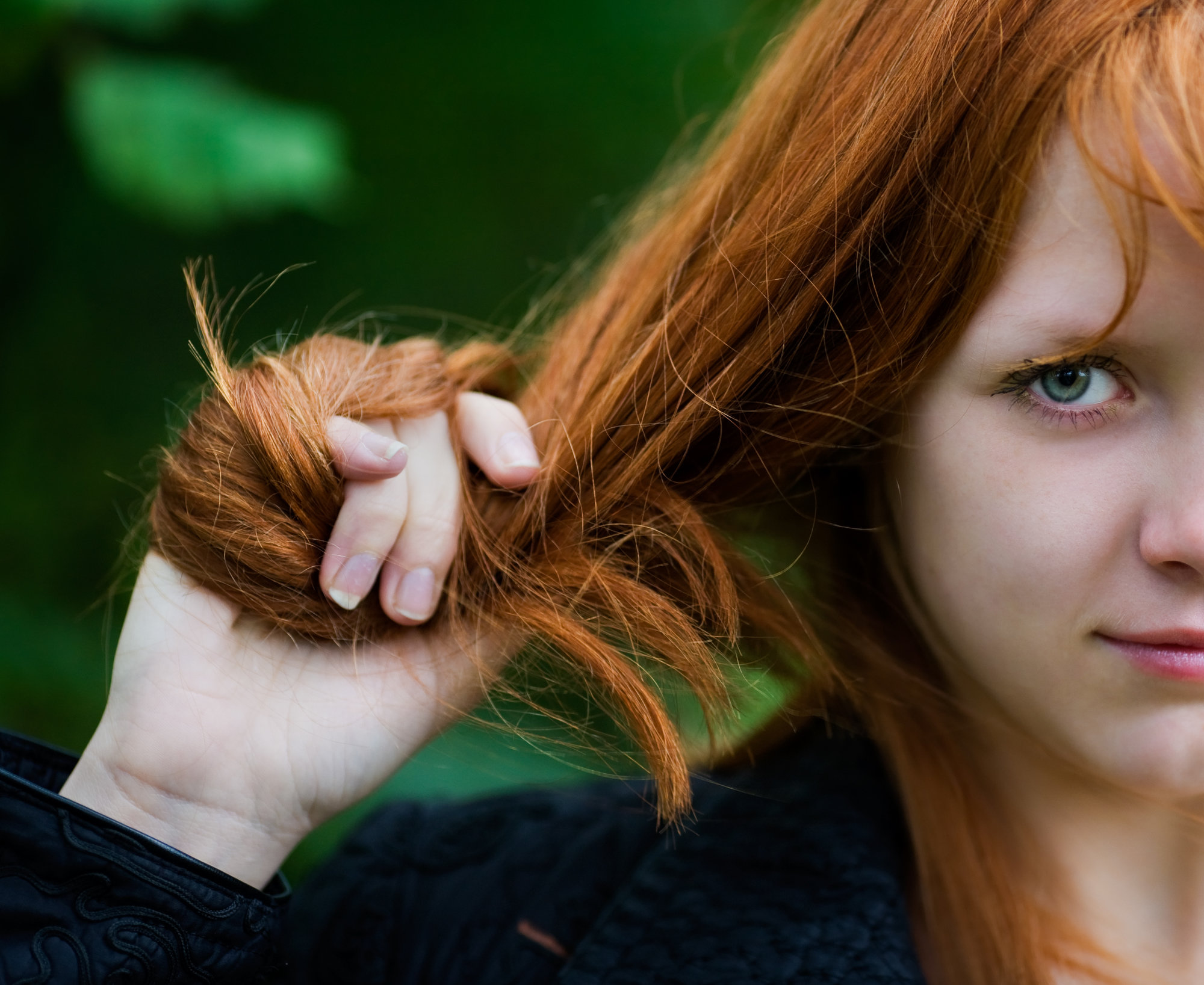While the condition is remarkably common, even experts say they have more questions than answers about the disease: For example, no one knows why adult women are disproportionately affected by the disorder. “It’s extremely embarrassing and self-defeating,” a 24-year-old survivor, who still struggles with Trich, told Revelist. “I’ve thought about shaving my head and starting over, I’ve tried wigs, but there is no hiding from yourself.” Much of the shame survivors feel stems from the lack of education about Trichotillomania — that their illness isn’t a moral failing, and that help is available to them. Revelist spoke to Jennifer Raikes, executive director of the TLC Foundation for Body-Focused Repetitve Disorders, about what survivors and their loved ones should know about Trichotillomania. “Trichotillomania is a mental health disorder when you have the compulsion to pull out your hair to the point where it’s causing you distress, or where it’s disrupting your life in some way,” she said. “It could be your head hair, it could be your eyelashes, it could be your eyebrows. It could be pretty much any hair on your body, the most common being head hair.” Many sufferers don’t even realize the consequences of the disease. “I first started pulling out my hair during high school, I don’t know why I started it just seemed to calm me down when my anxiety would kick in,” Maggie (name changed), who is 24, told Revelist. “It’s a strange cycle though because I would start picking my scalp and pull my hair out in one spot — usually where I could easily hide it.” Maggie, who still occasionally struggles, said Trich can quickly become a vicious cycle of relief and grief. “I would find one particular hair that had a root on it, and I would feel a sense of release. Then I would realize how much hair I had plucked out and my anxiety would get worse.” Though women are disproportionately affected by Trich, people of all genders can struggle. “I began pulling my eyelashes when I was 8, which later progressed to tweezing body hair,” “Jamie,” (name changed), a genderqueer person from New Jersey, told Revelist. “I am not sure when it started, but it was around the time that I was molested. [It] intensified after being kidnapped by parent.” “These problems often start in childhood, so it’s often the parents who are helping the child to find help,” Raikes said. “But one of the big barriers to anyone getting help is that [Trich] is not well-known. [Trich is] really common, but it’s not well-known.” “I think that’s because we feel ashamed…and we think they’re our fault,” she added. “Often, it’s people’s biggest secret.” “In addition to all the time a person spends doing the behaviors, there’s also the shame and the hiding…the ways in which we adapt our life in order to not reveal these problems,” Raike told Revelist. “Many experts are not trained in these problems, so it’s really up to the parents to educate themselves.” Struggling with Trich — or any mental health issue — doesn’t make you a bad person; help is possible, and you are lovable.




title: “What You Should Know About Trichotillomania” ShowToc: true date: “2024-09-02” author: “Margaret Carson”
While the condition is remarkably common, even experts say they have more questions than answers about the disease: For example, no one knows why adult women are disproportionately affected by the disorder. “It’s extremely embarrassing and self-defeating,” a 24-year-old survivor, who still struggles with Trich, told Revelist. “I’ve thought about shaving my head and starting over, I’ve tried wigs, but there is no hiding from yourself.” Much of the shame survivors feel stems from the lack of education about Trichotillomania — that their illness isn’t a moral failing, and that help is available to them. Revelist spoke to Jennifer Raikes, executive director of the TLC Foundation for Body-Focused Repetitve Disorders, about what survivors and their loved ones should know about Trichotillomania. “Trichotillomania is a mental health disorder when you have the compulsion to pull out your hair to the point where it’s causing you distress, or where it’s disrupting your life in some way,” she said. “It could be your head hair, it could be your eyelashes, it could be your eyebrows. It could be pretty much any hair on your body, the most common being head hair.” Many sufferers don’t even realize the consequences of the disease. “I first started pulling out my hair during high school, I don’t know why I started it just seemed to calm me down when my anxiety would kick in,” Maggie (name changed), who is 24, told Revelist. “It’s a strange cycle though because I would start picking my scalp and pull my hair out in one spot — usually where I could easily hide it.” Maggie, who still occasionally struggles, said Trich can quickly become a vicious cycle of relief and grief. “I would find one particular hair that had a root on it, and I would feel a sense of release. Then I would realize how much hair I had plucked out and my anxiety would get worse.” Though women are disproportionately affected by Trich, people of all genders can struggle. “I began pulling my eyelashes when I was 8, which later progressed to tweezing body hair,” “Jamie,” (name changed), a genderqueer person from New Jersey, told Revelist. “I am not sure when it started, but it was around the time that I was molested. [It] intensified after being kidnapped by parent.” “These problems often start in childhood, so it’s often the parents who are helping the child to find help,” Raikes said. “But one of the big barriers to anyone getting help is that [Trich] is not well-known. [Trich is] really common, but it’s not well-known.” “I think that’s because we feel ashamed…and we think they’re our fault,” she added. “Often, it’s people’s biggest secret.” “In addition to all the time a person spends doing the behaviors, there’s also the shame and the hiding…the ways in which we adapt our life in order to not reveal these problems,” Raike told Revelist. “Many experts are not trained in these problems, so it’s really up to the parents to educate themselves.” Struggling with Trich — or any mental health issue — doesn’t make you a bad person; help is possible, and you are lovable.




title: “What You Should Know About Trichotillomania” ShowToc: true date: “2024-09-22” author: “Corey Lehmann”
While the condition is remarkably common, even experts say they have more questions than answers about the disease: For example, no one knows why adult women are disproportionately affected by the disorder. “It’s extremely embarrassing and self-defeating,” a 24-year-old survivor, who still struggles with Trich, told Revelist. “I’ve thought about shaving my head and starting over, I’ve tried wigs, but there is no hiding from yourself.” Much of the shame survivors feel stems from the lack of education about Trichotillomania — that their illness isn’t a moral failing, and that help is available to them. Revelist spoke to Jennifer Raikes, executive director of the TLC Foundation for Body-Focused Repetitve Disorders, about what survivors and their loved ones should know about Trichotillomania. “Trichotillomania is a mental health disorder when you have the compulsion to pull out your hair to the point where it’s causing you distress, or where it’s disrupting your life in some way,” she said. “It could be your head hair, it could be your eyelashes, it could be your eyebrows. It could be pretty much any hair on your body, the most common being head hair.” Many sufferers don’t even realize the consequences of the disease. “I first started pulling out my hair during high school, I don’t know why I started it just seemed to calm me down when my anxiety would kick in,” Maggie (name changed), who is 24, told Revelist. “It’s a strange cycle though because I would start picking my scalp and pull my hair out in one spot — usually where I could easily hide it.” Maggie, who still occasionally struggles, said Trich can quickly become a vicious cycle of relief and grief. “I would find one particular hair that had a root on it, and I would feel a sense of release. Then I would realize how much hair I had plucked out and my anxiety would get worse.” Though women are disproportionately affected by Trich, people of all genders can struggle. “I began pulling my eyelashes when I was 8, which later progressed to tweezing body hair,” “Jamie,” (name changed), a genderqueer person from New Jersey, told Revelist. “I am not sure when it started, but it was around the time that I was molested. [It] intensified after being kidnapped by parent.” “These problems often start in childhood, so it’s often the parents who are helping the child to find help,” Raikes said. “But one of the big barriers to anyone getting help is that [Trich] is not well-known. [Trich is] really common, but it’s not well-known.” “I think that’s because we feel ashamed…and we think they’re our fault,” she added. “Often, it’s people’s biggest secret.” “In addition to all the time a person spends doing the behaviors, there’s also the shame and the hiding…the ways in which we adapt our life in order to not reveal these problems,” Raike told Revelist. “Many experts are not trained in these problems, so it’s really up to the parents to educate themselves.” Struggling with Trich — or any mental health issue — doesn’t make you a bad person; help is possible, and you are lovable.



